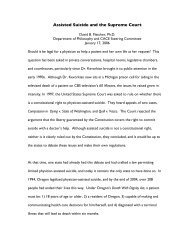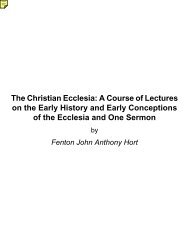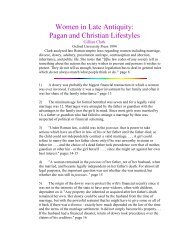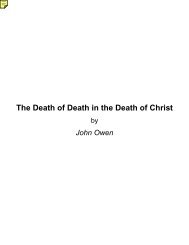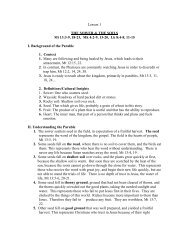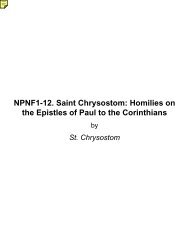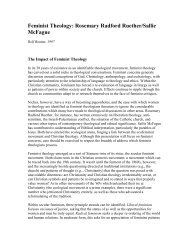- Page 1 and 2:
NPNF1-14. Saint Chrysostom: <strong
- Page 3 and 4:
NPNF1-14. Saint Chrysostom: <strong
- Page 6 and 7:
NPNF1-14. Saint Chrysostom: <strong
- Page 8 and 9:
NPNF (V1-14)St. ChrysostomvPreface.
- Page 10 and 11:
NPNF (V1-14)St. ChrysostomTempter..
- Page 12 and 13:
NPNF (V1-14)St. ChrysostomixTHE HOM
- Page 14 and 15:
NPNF (V1-14)St. ChrysostomThe text
- Page 16 and 17:
NPNF (V1-14)St. Chrysostom2truth it
- Page 18 and 19:
NPNF (V1-14)St. Chrysostom4the extr
- Page 20 and 21:
NPNF (V1-14)St. Chrysostom5all know
- Page 22 and 23:
NPNF (V1-14)St. Chrysostomnature of
- Page 24 and 25:
NPNF (V1-14)St. Chrysostom8nowhere
- Page 26 and 27:
NPNF (V1-14)St. ChrysostomFor this
- Page 28 and 29:
NPNF (V1-14)St. Chrysostom11and if
- Page 30 and 31:
NPNF (V1-14)St. Chrysostom12man,”
- Page 32 and 33:
NPNF (V1-14)St. Chrysostom14to the
- Page 34 and 35:
NPNF (V1-14)St. Chrysostom15should
- Page 36 and 37:
NPNF (V1-14)St. ChrysostomJohn i. 1
- Page 38 and 39:
NPNF (V1-14)St. Chrysostom18not dep
- Page 40 and 41:
NPNF (V1-14)St. Chrysostom19busy on
- Page 42 and 43:
NPNF (V1-14)St. Chrysostomwickednes
- Page 44 and 45:
NPNF (V1-14)St. Chrysostom22Him tha
- Page 46 and 47:
NPNF (V1-14)St. ChrysostomEssence o
- Page 48 and 49:
NPNF (V1-14)St. Chrysostom25[4.] Bu
- Page 50 and 51:
NPNF (V1-14)St. Chrysostom26this pl
- Page 52 and 53:
NPNF (V1-14)St. Chrysostomthe glory
- Page 54 and 55:
NPNF (V1-14)St. Chrysostom29This ex
- Page 56 and 57:
NPNF (V1-14)St. Chrysostom30madness
- Page 58 and 59:
NPNF (V1-14)St. ChrysostomKnowing t
- Page 60 and 61:
NPNF (V1-14)St. Chrysostom33the com
- Page 62 and 63:
NPNF (V1-14)St. Chrysostomhadst had
- Page 64 and 65:
NPNF (V1-14)St. Chrysostom36these m
- Page 66 and 67:
NPNF (V1-14)St. Chrysostom37be, if
- Page 68 and 69:
NPNF (V1-14)St. Chrysostommake upon
- Page 70 and 71:
NPNF (V1-14)St. Chrysostom39one thi
- Page 72 and 73:
NPNF (V1-14)St. Chrysostom40brightn
- Page 74 and 75:
NPNF (V1-14)St. Chrysostomrank of d
- Page 76 and 77:
NPNF (V1-14)St. ChrysostomHomily XI
- Page 78 and 79:
NPNF (V1-14)St. Chrysostom44to many
- Page 80 and 81:
NPNF (V1-14)St. Chrysostomfirst mus
- Page 82 and 83:
NPNF (V1-14)St. Chrysostom47than he
- Page 84 and 85:
NPNF (V1-14)St. Chrysostom48these w
- Page 86 and 87:
NPNF (V1-14)St. Chrysostomfulfilled
- Page 88 and 89:
NPNF (V1-14)St. Chrysostom51one is
- Page 90 and 91:
NPNF (V1-14)St. Chrysostomwould He
- Page 92 and 93:
NPNF (V1-14)St. Chrysostomcalled al
- Page 94 and 95:
NPNF (V1-14)St. Chrysostom55multitu
- Page 96 and 97:
NPNF (V1-14)St. Chrysostomis plain
- Page 98 and 99:
NPNF (V1-14)St. ChrysostomHomily XV
- Page 100 and 101:
NPNF (V1-14)St. Chrysostom59But in
- Page 102 and 103:
NPNF (V1-14)St. ChrysostomWhere did
- Page 104 and 105:
NPNF (V1-14)St. ChrysostomJohn i. 3
- Page 106 and 107:
NPNF (V1-14)St. Chrysostom63as not
- Page 108 and 109:
NPNF (V1-14)St. Chrysostomthe house
- Page 110 and 111:
NPNF (V1-14)St. Chrysostomthem is n
- Page 112 and 113:
NPNF (V1-14)St. Chrysostomnot so. W
- Page 114 and 115:
NPNF (V1-14)St. Chrysostomrest will
- Page 116 and 117:
NPNF (V1-14)St. Chrysostom70easily
- Page 118 and 119:
NPNF (V1-14)St. Chrysostomsmall, ap
- Page 120 and 121:
NPNF (V1-14)St. Chrysostom73I said
- Page 122 and 123:
NPNF (V1-14)St. Chrysostom74but be
- Page 124 and 125:
NPNF (V1-14)St. Chrysostomand being
- Page 126 and 127:
NPNF (V1-14)St. Chrysostom77been in
- Page 128 and 129:
NPNF (V1-14)St. Chrysostom78away al
- Page 130 and 131:
NPNF (V1-14)St. Chrysostom“How?
- Page 132 and 133:
NPNF (V1-14)St. Chrysostom81and fre
- Page 134 and 135:
NPNF (V1-14)St. Chrysostom82“But,
- Page 136 and 137:
NPNF (V1-14)St. ChrysostomWherefore
- Page 138 and 139:
NPNF (V1-14)St. Chrysostom85Callest
- Page 140 and 141:
NPNF (V1-14)St. Chrysostom[1.] Litt
- Page 142 and 143:
NPNF (V1-14)St. Chrysostom88accompl
- Page 144 and 145:
NPNF (V1-14)St. Chrysostom89arrival
- Page 146 and 147:
NPNF (V1-14)St. Chrysostom“That w
- Page 148 and 149:
NPNF (V1-14)St. Chrysostom92This He
- Page 150 and 151:
NPNF (V1-14)St. Chrysostom93awful G
- Page 152 and 153:
NPNF (V1-14)St. Chrysostomwho, ungr
- Page 154 and 155:
NPNF (V1-14)St. Chrysostom96lovingk
- Page 156 and 157:
NPNF (V1-14)St. Chrysostom97without
- Page 158 and 159:
NPNF (V1-14)St. Chrysostomunbelief
- Page 160 and 161:
NPNF (V1-14)St. Chrysostom100If any
- Page 162 and 163:
NPNF (V1-14)St. Chrysostom101called
- Page 164 and 165:
NPNF (V1-14)St. Chrysostom“He tha
- Page 166 and 167:
NPNF (V1-14)St. Chrysostom104Ver. 3
- Page 168 and 169:
NPNF (V1-14)St. Chrysostom105Homily
- Page 170 and 171:
NPNF (V1-14)St. Chrysostomintroduce
- Page 172 and 173:
NPNF (V1-14)St. Chrysostom108the wa
- Page 174 and 175:
NPNF (V1-14)St. Chrysostom109induce
- Page 176 and 177:
NPNF (V1-14)St. Chrysostomelse but
- Page 178 and 179:
NPNF (V1-14)St. Chrysostom112The wo
- Page 180 and 181:
NPNF (V1-14)St. Chrysostom113Ver. 2
- Page 182 and 183:
NPNF (V1-14)St. ChrysostomJohn iv.
- Page 184 and 185:
NPNF (V1-14)St. Chrysostom116Ver. 2
- Page 186 and 187:
NPNF (V1-14)St. Chrysostom117What t
- Page 188 and 189:
NPNF (V1-14)St. Chrysostomthe repro
- Page 190 and 191:
NPNF (V1-14)St. Chrysostom120Ver. 3
- Page 192 and 193:
NPNF (V1-14)St. Chrysostom121a woma
- Page 194 and 195:
NPNF (V1-14)St. Chrysostomimportant
- Page 196 and 197:
NPNF (V1-14)St. Chrysostomless than
- Page 198 and 199:
NPNF (V1-14)St. Chrysostom125to fea
- Page 200 and 201:
NPNF (V1-14)St. Chrysostomallowed y
- Page 202 and 203:
NPNF (V1-14)St. Chrysostom128us, re
- Page 204 and 205:
NPNF (V1-14)St. Chrysostom129All bu
- Page 206 and 207:
NPNF (V1-14)St. ChrysostomJohn v. 1
- Page 208 and 209:
NPNF (V1-14)St. Chrysostom132case,
- Page 210 and 211:
NPNF (V1-14)St. Chrysostom133rest a
- Page 212 and 213:
NPNF (V1-14)St. Chrysostom135unwill
- Page 214 and 215:
NPNF (V1-14)St. Chrysostomthan this
- Page 216 and 217:
NPNF (V1-14)St. Chrysostomhimself s
- Page 218 and 219:
NPNF (V1-14)St. Chrysostom139thou h
- Page 220 and 221:
NPNF (V1-14)St. Chrysostom140these
- Page 222 and 223:
NPNF (V1-14)St. ChrysostomNow beari
- Page 224 and 225:
NPNF (V1-14)St. Chrysostom143they w
- Page 226 and 227:
NPNF (V1-14)St. Chrysostom144that n
- Page 228 and 229:
NPNF (V1-14)St. Chrysostom“Nor se
- Page 230 and 231:
NPNF (V1-14)St. ChrysostomHomily XL
- Page 232 and 233:
NPNF (V1-14)St. Chrysostom147Ver. 4
- Page 234 and 235:
NPNF (V1-14)St. Chrysostominjustice
- Page 236 and 237:
NPNF (V1-14)St. Chrysostom150multit
- Page 238 and 239:
NPNF (V1-14)St. Chrysostom151“who
- Page 240 and 241:
NPNF (V1-14)St. ChrysostomLearn we
- Page 242 and 243:
NPNF (V1-14)St. Chrysostoma cause t
- Page 244 and 245:
NPNF (V1-14)St. Chrysostom155The Je
- Page 246 and 247:
NPNF (V1-14)St. Chrysostom156them.
- Page 248 and 249:
NPNF (V1-14)St. Chrysostomof presen
- Page 250 and 251:
NPNF (V1-14)St. Chrysostom159He dot
- Page 252 and 253:
NPNF (V1-14)St. Chrysostom160delive
- Page 254 and 255:
NPNF (V1-14)St. Chrysostomthese thi
- Page 256 and 257:
NPNF (V1-14)St. Chrysostom163father
- Page 258 and 259:
NPNF (V1-14)St. Chrysostom164words.
- Page 260 and 261:
NPNF (V1-14)St. Chrysostomclearly p
- Page 262 and 263:
NPNF (V1-14)St. Chrysostom1671324fo
- Page 264 and 265:
NPNF (V1-14)St. ChrysostomHe said
- Page 266 and 267:
NPNF (V1-14)St. Chrysostom170recall
- Page 268 and 269:
NPNF (V1-14)St. Chrysostomhusbands,
- Page 270 and 271:
NPNF (V1-14)St. Chrysostomalso is s
- Page 272 and 273:
NPNF (V1-14)St. Chrysostomfire. “
- Page 274 and 275:
NPNF (V1-14)St. Chrysostom175By the
- Page 276 and 277:
NPNF (V1-14)St. Chrysostomman is no
- Page 278 and 279:
NPNF (V1-14)St. Chrysostomconfidenc
- Page 280 and 281:
NPNF (V1-14)St. Chrysostom179this,
- Page 282 and 283:
NPNF (V1-14)St. Chrysostomdesired b
- Page 284 and 285:
NPNF (V1-14)St. Chrysostom182kind,
- Page 286 and 287:
NPNF (V1-14)St. Chrysostom183But wh
- Page 288 and 289:
NPNF (V1-14)St. Chrysostom1446which
- Page 290 and 291:
NPNF (V1-14)St. Chrysostom186this e
- Page 292 and 293:
NPNF (V1-14)St. ChrysostomFather. B
- Page 294 and 295:
NPNF (V1-14)St. Chrysostom189ask,
- Page 296 and 297:
NPNF (V1-14)St. ChrysostomFor He to
- Page 298 and 299:
NPNF (V1-14)St. Chrysostom192and jo
- Page 300 and 301:
NPNF (V1-14)St. Chrysostom193Gently
- Page 302 and 303:
NPNF (V1-14)St. Chrysostom“We hav
- Page 304 and 305:
NPNF (V1-14)St. Chrysostom196“Tho
- Page 306 and 307:
NPNF (V1-14)St. Chrysostom197Here t
- Page 308 and 309:
NPNF (V1-14)St. Chrysostom“And as
- Page 310 and 311:
NPNF (V1-14)St. Chrysostom200But wh
- Page 312 and 313:
NPNF (V1-14)St. Chrysostomcandle, s
- Page 314 and 315:
NPNF (V1-14)St. Chrysostom203But ob
- Page 316 and 317:
NPNF (V1-14)St. ChrysostomThese, on
- Page 318 and 319:
NPNF (V1-14)St. Chrysostom206the mo
- Page 320 and 321:
NPNF (V1-14)St. Chrysostom207For to
- Page 322 and 323:
NPNF (V1-14)St. Chrysostom208wisdom
- Page 324 and 325:
NPNF (V1-14)St. Chrysostom210space
- Page 326 and 327:
NPNF (V1-14)St. Chrysostom211He sai
- Page 328 and 329:
NPNF (V1-14)St. Chrysostomthat they
- Page 330 and 331:
NPNF (V1-14)St. Chrysostom214“Ble
- Page 332 and 333:
NPNF (V1-14)St. Chrysostom215accoun
- Page 334 and 335:
NPNF (V1-14)St. ChrysostomBut let u
- Page 336 and 337:
NPNF (V1-14)St. Chrysostom218things
- Page 338 and 339:
NPNF (V1-14)St. Chrysostom219adulte
- Page 340 and 341:
NPNF (V1-14)St. ChrysostomJohn x. 2
- Page 342 and 343:
NPNF (V1-14)St. Chrysostom222Ver. 2
- Page 344 and 345:
NPNF (V1-14)St. Chrysostomhaving do
- Page 346 and 347:
NPNF (V1-14)St. Chrysostomher partn
- Page 348 and 349:
NPNF (V1-14)St. Chrysostom226Ver. 7
- Page 350 and 351:
NPNF (V1-14)St. Chrysostomnot more
- Page 352 and 353:
NPNF (V1-14)St. Chrysostom229engrav
- Page 354:
NPNF (V1-14)St. Chrysostommourn for
- Page 358 and 359:
NPNF (V1-14)St. Chrysostommathemati
- Page 360 and 361:
NPNF (V1-14)St. ChrysostomHow is it
- Page 362 and 363:
NPNF (V1-14)St. Chrysostomsaying, t
- Page 364 and 365:
NPNF (V1-14)St. Chrysostom237Him wi
- Page 366 and 367:
NPNF (V1-14)St. Chrysostom238things
- Page 368 and 369:
NPNF (V1-14)St. Chrysostomthey had
- Page 370 and 371:
NPNF (V1-14)St. Chrysostom241permis
- Page 372 and 373:
NPNF (V1-14)St. Chrysostom242is 185
- Page 374 and 375:
NPNF (V1-14)St. ChrysostomBut how,
- Page 376 and 377:
NPNF (V1-14)St. Chrysostom245of all
- Page 378 and 379:
NPNF (V1-14)St. Chrysostomwill bid
- Page 380 and 381:
NPNF (V1-14)St. ChrysostomAs though
- Page 382 and 383:
NPNF (V1-14)St. Chrysostomblaspheme
- Page 384 and 385:
NPNF (V1-14)St. Chrysostomwith word
- Page 386 and 387:
NPNF (V1-14)St. Chrysostom[3.] Know
- Page 388 and 389:
NPNF (V1-14)St. ChrysostomVer. 49 .
- Page 390 and 391:
NPNF (V1-14)St. ChrysostomFor they
- Page 392 and 393:
NPNF (V1-14)St. Chrysostom256Ver. 3
- Page 394 and 395:
NPNF (V1-14)St. Chrysostom257but wi
- Page 396 and 397:
NPNF (V1-14)St. Chrysostom259“one
- Page 398 and 399:
NPNF (V1-14)St. Chrysostom260“hat
- Page 400 and 401:
NPNF (V1-14)St. Chrysostom[1.] Grea
- Page 402 and 403:
NPNF (V1-14)St. ChrysostomVer. 27 .
- Page 404 and 405:
NPNF (V1-14)St. Chrysostom264but st
- Page 406 and 407:
NPNF (V1-14)St. Chrysostom265dost t
- Page 408 and 409:
NPNF (V1-14)St. Chrysostombut cutte
- Page 410 and 411:
NPNF (V1-14)St. Chrysostom268I am,
- Page 412 and 413:
NPNF (V1-14)St. Chrysostomsince for
- Page 414 and 415:
NPNF (V1-14)St. Chrysostom[2.] Thou
- Page 416 and 417:
NPNF (V1-14)St. Chrysostomtender ca
- Page 418 and 419:
NPNF (V1-14)St. Chrysostom273[2.]
- Page 420 and 421:
NPNF (V1-14)St. ChrysostomVer. 24 .
- Page 422 and 423:
NPNF (V1-14)St. Chrysostom276pass,
- Page 424 and 425:
NPNF (V1-14)St. Chrysostom277them,
- Page 426 and 427:
NPNF (V1-14)St. ChrysostomThis He s
- Page 428 and 429:
NPNF (V1-14)St. Chrysostomand bonds
- Page 430 and 431:
NPNF (V1-14)St. Chrysostom281after
- Page 432 and 433:
NPNF (V1-14)St. ChrysostomCh. xvi.
- Page 434 and 435:
NPNF (V1-14)St. Chrysostom284have,
- Page 436 and 437:
NPNF (V1-14)St. Chrysostomstarted n
- Page 438 and 439:
NPNF (V1-14)St. Chrysostom287“He
- Page 440 and 441:
NPNF (V1-14)St. Chrysostom288should
- Page 442 and 443:
NPNF (V1-14)St. Chrysostomsubject,
- Page 444 and 445:
NPNF (V1-14)St. Chrysostom291ye wil
- Page 446 and 447:
NPNF (V1-14)St. Chrysostom292of tho
- Page 448 and 449:
NPNF (V1-14)St. Chrysostomexperienc
- Page 450 and 451:
NPNF (V1-14)St. Chrysostom295old, p
- Page 452 and 453:
NPNF (V1-14)St. Chrysostomthings? H
- Page 454 and 455:
NPNF (V1-14)St. Chrysostom298“Who
- Page 456 and 457:
NPNF (V1-14)St. Chrysostom299addres
- Page 458 and 459:
NPNF (V1-14)St. Chrysostomfrom cove
- Page 460 and 461:
NPNF (V1-14)St. Chrysostom302What i
- Page 462 and 463:
NPNF (V1-14)St. Chrysostom303This a
- Page 464 and 465:
NPNF (V1-14)St. Chrysostomonly. But
- Page 466 and 467:
NPNF (V1-14)St. Chrysostom306Seest
- Page 468 and 469:
NPNF (V1-14)St. Chrysostom307follow
- Page 470 and 471:
NPNF (V1-14)St. ChrysostomNot as ac
- Page 472 and 473:
NPNF (V1-14)St. Chrysostom310not’
- Page 474 and 475:
NPNF (V1-14)St. ChrysostomJohn xvii
- Page 476 and 477:
NPNF (V1-14)St. Chrysostom“How th
- Page 478 and 479:
NPNF (V1-14)St. Chrysostom314injust
- Page 480 and 481:
NPNF (V1-14)St. Chrysostom315at sov
- Page 482 and 483:
NPNF (V1-14)St. Chrysostomhim when
- Page 484 and 485:
NPNF (V1-14)St. Chrysostom318beginn
- Page 486 and 487:
NPNF (V1-14)St. Chrysostom319Seest
- Page 488 and 489:
NPNF (V1-14)St. Chrysostompower of
- Page 490 and 491:
NPNF (V1-14)St. Chrysostom322“Wha
- Page 492 and 493:
NPNF (V1-14)St. Chrysostom323to com
- Page 494 and 495:
NPNF (V1-14)St. Chrysostomwicked in
- Page 496 and 497:
NPNF (V1-14)St. Chrysostom326whence
- Page 498 and 499:
NPNF (V1-14)St. Chrysostom327Having
- Page 500 and 501:
NPNF (V1-14)St. Chrysostomthe sake
- Page 502 and 503:
NPNF (V1-14)St. Chrysostom330him th
- Page 504 and 505:
NPNF (V1-14)St. Chrysostom331what s
- Page 506 and 507:
NPNF (V1-14)St. Chrysostomwhile cov
- Page 508 and 509:
NPNF (V1-14)St. Chrysostom338the Ap
- Page 510 and 511:
NPNF (V1-14)St. ChrysostomAfter the
- Page 512 and 513:
NPNF (V1-14)St. Chrysostom343Thus f
- Page 514 and 515:
NPNF (V1-14)St. Chrysostom344When w
- Page 516 and 517:
NPNF (V1-14)St. Chrysostom346Anothe
- Page 518 and 519:
NPNF (V1-14)St. Chrysostom348......
- Page 520 and 521:
NPNF (V1-14)St. Chrysostom350Furthe
- Page 522 and 523:
NPNF (V1-14)St. Chrysostom352μ and
- Page 524 and 525:
NPNF (V1-14)St. Chrysostom354Mark,
- Page 526 and 527:
NPNF (V1-14)St. Chrysostomevery edu
- Page 528 and 529:
NPNF (V1-14)St. Chrysostom357probab
- Page 530 and 531:
NPNF (V1-14)St. ChrysostomArgument.
- Page 532 and 533:
NPNF (V1-14)St. Chrysostom365there
- Page 534 and 535:
NPNF (V1-14)St. Chrysostom“There
- Page 536 and 537:
NPNF (V1-14)St. Chrysostomgreat. Wh
- Page 538 and 539:
NPNF (V1-14)St. Chrysostom369from t
- Page 540 and 541:
NPNF (V1-14)St. ChrysostomWhich may
- Page 542 and 543:
NPNF (V1-14)St. Chrysostomup again
- Page 544 and 545:
NPNF (V1-14)St. Chrysostom373someth
- Page 546 and 547:
NPNF (V1-14)St. Chrysostom374alone,
- Page 548 and 549:
NPNF (V1-14)St. Chrysostom376am com
- Page 550 and 551:
NPNF (V1-14)St. Chrysostom377things
- Page 552 and 553:
NPNF (V1-14)St. ChrysostomNext, whe
- Page 554 and 555:
NPNF (V1-14)St. Chrysostom380even i
- Page 556 and 557:
NPNF (V1-14)St. Chrysostomexcelling
- Page 558 and 559:
NPNF (V1-14)St. Chrysostom383“whe
- Page 560 and 561:
NPNF (V1-14)St. Chrysostomof this w
- Page 562 and 563:
NPNF (V1-14)St. Chrysostom386could
- Page 564 and 565:
NPNF (V1-14)St. Chrysostom387May Go
- Page 566 and 567:
NPNF (V1-14)St. ChrysostomHomily V.
- Page 568 and 569:
NPNF (V1-14)St. Chrysostom390now it
- Page 570 and 571:
NPNF (V1-14)St. Chrysostomthe proph
- Page 572 and 573:
NPNF (V1-14)St. Chrysostom393The li
- Page 574 and 575:
NPNF (V1-14)St. Chrysostomand retur
- Page 576 and 577:
NPNF (V1-14)St. Chrysostom396agree,
- Page 578 and 579:
NPNF (V1-14)St. Chrysostom397that H
- Page 580 and 581:
NPNF (V1-14)St. Chrysostomalso. So
- Page 582 and 583:
NPNF (V1-14)St. Chrysostom400[4.] N
- Page 584 and 585:
NPNF (V1-14)St. Chrysostom401[7.] L
- Page 586 and 587:
NPNF (V1-14)St. Chrysostomwhen he n
- Page 588 and 589:
NPNF (V1-14)St. Chrysostom404Then a
- Page 590 and 591:
NPNF (V1-14)St. Chrysostomthat perh
- Page 592 and 593:
NPNF (V1-14)St. Chrysostom407perfec
- Page 594 and 595:
NPNF (V1-14)St. Chrysostom408is a s
- Page 596 and 597:
NPNF (V1-14)St. Chrysostomoften dis
- Page 598 and 599:
NPNF (V1-14)St. Chrysostom411And se
- Page 600 and 601:
NPNF (V1-14)St. Chrysostom412be for
- Page 602 and 603:
NPNF (V1-14)St. ChrysostomWhen was
- Page 604 and 605:
NPNF (V1-14)St. Chrysostom415‘tha
- Page 606 and 607:
NPNF (V1-14)St. Chrysostom416And he
- Page 608 and 609:
NPNF (V1-14)St. Chrysostomthee what
- Page 610 and 611:
NPNF (V1-14)St. Chrysostom419[2.]
- Page 612 and 613:
NPNF (V1-14)St. Chrysostomthrough t
- Page 614 and 615:
NPNF (V1-14)St. Chrysostom422respec
- Page 616 and 617:
NPNF (V1-14)St. Chrysostomis, King
- Page 618 and 619:
NPNF (V1-14)St. Chrysostom425Ver. 5
- Page 620 and 621:
NPNF (V1-14)St. Chrysostom426And he
- Page 622 and 623:
NPNF (V1-14)St. Chrysostom“If the
- Page 624 and 625:
NPNF (V1-14)St. Chrysostom429What i
- Page 626 and 627:
NPNF (V1-14)St. Chrysostom430during
- Page 628 and 629:
NPNF (V1-14)St. Chrysostom431worthy
- Page 630 and 631:
NPNF (V1-14)St. Chrysostomwithout a
- Page 632 and 633:
NPNF (V1-14)St. Chrysostom434Theref
- Page 634 and 635:
NPNF (V1-14)St. ChrysostomHe is not
- Page 636 and 637:
NPNF (V1-14)St. ChrysostomAnd besid
- Page 638 and 639:
NPNF (V1-14)St. Chrysostom438mornin
- Page 640 and 641:
NPNF (V1-14)St. Chrysostom439servic
- Page 642 and 643:
NPNF (V1-14)St. Chrysostom440Ver. 1
- Page 644 and 645:
NPNF (V1-14)St. Chrysostomrefuse [t
- Page 646 and 647:
NPNF (V1-14)St. Chrysostomto entrea
- Page 648 and 649:
NPNF (V1-14)St. Chrysostom444Why th
- Page 650 and 651:
NPNF (V1-14)St. Chrysostomleft the
- Page 652 and 653:
NPNF (V1-14)St. ChrysostomHomily XV
- Page 654 and 655:
NPNF (V1-14)St. Chrysostom448Ver. 2
- Page 656 and 657:
NPNF (V1-14)St. Chrysostom[6.] What
- Page 658 and 659:
NPNF (V1-14)St. Chrysostomneedful t
- Page 660 and 661:
NPNF (V1-14)St. Chrysostom452[2.] A
- Page 662 and 663:
NPNF (V1-14)St. Chrysostomespeciall
- Page 664 and 665:
NPNF (V1-14)St. Chrysostom455that t
- Page 666 and 667:
NPNF (V1-14)St. Chrysostom456What i
- Page 668 and 669:
NPNF (V1-14)St. Chrysostomand hande
- Page 670 and 671:
NPNF (V1-14)St. Chrysostom459to com
- Page 672 and 673:
NPNF (V1-14)St. Chrysostomnot gaine
- Page 674 and 675:
NPNF (V1-14)St. Chrysostom462Then h
- Page 676 and 677:
NPNF (V1-14)St. Chrysostom463[4.] (
- Page 678 and 679:
NPNF (V1-14)St. Chrysostomthou maye
- Page 680 and 681:
NPNF (V1-14)St. Chrysostom466[2.] W
- Page 682 and 683:
NPNF (V1-14)St. Chrysostom467How do
- Page 684 and 685:
NPNF (V1-14)St. Chrysostomseek it;
- Page 686 and 687:
NPNF (V1-14)St. Chrysostom470equal
- Page 688 and 689:
NPNF (V1-14)St. Chrysostom471“And
- Page 690 and 691:
NPNF (V1-14)St. Chrysostombenefits
- Page 692 and 693:
NPNF (V1-14)St. ChrysostomHomily XX
- Page 694 and 695:
NPNF (V1-14)St. Chrysostom475enjoye
- Page 696 and 697:
NPNF (V1-14)St. Chrysostom477For te
- Page 698 and 699:
NPNF (V1-14)St. Chrysostom478said,
- Page 700 and 701:
NPNF (V1-14)St. Chrysostom[4.] Thou
- Page 702 and 703:
NPNF (V1-14)St. Chrysostom481give a
- Page 704 and 705:
NPNF (V1-14)St. Chrysostom482[1.]
- Page 706 and 707:
NPNF (V1-14)St. ChrysostomHe has na
- Page 708 and 709:
NPNF (V1-14)St. Chrysostom485undert
- Page 710 and 711:
NPNF (V1-14)St. Chrysostom486when e
- Page 712 and 713:
NPNF (V1-14)St. Chrysostom488night:
- Page 714 and 715:
NPNF (V1-14)St. Chrysostom489“the
- Page 716 and 717:
NPNF (V1-14)St. Chrysostomor so to
- Page 718 and 719:
NPNF (V1-14)St. ChrysostomHomily XX
- Page 720 and 721:
NPNF (V1-14)St. Chrysostom493witnes
- Page 722 and 723:
NPNF (V1-14)St. ChrysostomTo Him th
- Page 724 and 725:
NPNF (V1-14)St. Chrysostom496“all
- Page 726 and 727:
NPNF (V1-14)St. Chrysostom497For so
- Page 728 and 729:
NPNF (V1-14)St. ChrysostomGod with
- Page 730 and 731:
NPNF (V1-14)St. Chrysostom500“And
- Page 732 and 733:
NPNF (V1-14)St. Chrysostom501the ca
- Page 734 and 735:
NPNF (V1-14)St. Chrysostommuch to k
- Page 736 and 737:
NPNF (V1-14)St. Chrysostom504He spe
- Page 738 and 739:
NPNF (V1-14)St. Chrysostom[6.] But
- Page 740 and 741:
NPNF (V1-14)St. Chrysostom507And wi
- Page 742 and 743:
NPNF (V1-14)St. Chrysostom508[5.] F
- Page 744 and 745:
NPNF (V1-14)St. Chrysostombound, be
- Page 746 and 747:
NPNF (V1-14)St. Chrysostom511it he
- Page 748 and 749:
NPNF (V1-14)St. ChrysostomBut what
- Page 750 and 751:
NPNF (V1-14)St. Chrysostom514not we
- Page 752 and 753:
NPNF (V1-14)St. Chrysostom515all me
- Page 754 and 755:
NPNF (V1-14)St. Chrysostomthe woman
- Page 756 and 757:
NPNF (V1-14)St. Chrysostom518Son is
- Page 758 and 759:
NPNF (V1-14)St. Chrysostom519order;
- Page 760 and 761:
NPNF (V1-14)St. ChrysostomThou sees
- Page 762 and 763:
NPNF (V1-14)St. ChrysostomFor as a
- Page 764 and 765:
NPNF (V1-14)St. ChrysostomINDEXES O
- Page 766 and 767:
NPNF (V1-14)St. ChrysostomBirds, te
- Page 768 and 769:
NPNF (V1-14)St. Chrysostombelievers
- Page 770 and 771:
NPNF (V1-14)St. Chrysostomrequired
- Page 772 and 773:
NPNF (V1-14)St. ChrysostomCorinthia
- Page 774 and 775:
NPNF (V1-14)St. Chrysostomworld: of
- Page 776 and 777:
NPNF (V1-14)St. Chrysostom118; of t
- Page 778 and 779:
NPNF (V1-14)St. Chrysostom288; the
- Page 780 and 781:
NPNF (V1-14)St. ChrysostomJews, ib.
- Page 782 and 783:
NPNF (V1-14)St. ChrysostomLuxury, t
- Page 784 and 785:
NPNF (V1-14)St. ChrysostomPalestine
- Page 786 and 787:
NPNF (V1-14)St. ChrysostomPride, ru
- Page 788 and 789:
NPNF (V1-14)St. Chrysostomby their
- Page 790 and 791:
NPNF (V1-14)St. ChrysostomThat, exp
- Page 792 and 793:
NPNF (V1-14)St. ChrysostomWorldly m
- Page 794 and 795:
NPNF (V1-14)St. ChrysostomChrist, H
- Page 796 and 797:
NPNF (V1-14)St. ChrysostomDesire, i
- Page 798 and 799:
NPNF (V1-14)St. Chrysostomto man mo
- Page 800 and 801:
NPNF (V1-14)St. ChrysostomIndolence
- Page 802 and 803:
NPNF (V1-14)St. ChrysostomMourners,
- Page 804 and 805:
NPNF (V1-14)St. Chrysostomwhat, 490
- Page 806 and 807:
NPNF (V1-14)St. Chrysostomlxxvii.ci
- Page 808 and 809:
NPNF (V1-14)St. ChrysostomSoul, pun
- Page 810 and 811:
NPNF (V1-14)St. ChrysostomWorld, to
- Page 812 and 813:
NPNF (V1-14)St. Chrysostom10:5 10:5
- Page 814 and 815:
NPNF (V1-14)St. Chrysostom1:17 1:17
- Page 816 and 817:
NPNF (V1-14)St. Chrysostom19:30 19:
- Page 818 and 819:
NPNF (V1-14)St. Chrysostom9:23 9:24
- Page 820 and 821:
NPNF (V1-14)St. Chrysostom•Perhap
- Page 822 and 823: NPNF (V1-14)St. Chrysostom•ἄ γ
- Page 824 and 825: NPNF (V1-14)St. Chrysostom•Δεσ
- Page 826 and 827: NPNF (V1-14)St. Chrysostom•βο
- Page 828 and 829: NPNF (V1-14)St. Chrysostom•δευ
- Page 830 and 831: NPNF (V1-14)St. Chrysostom•εἰ
- Page 832 and 833: NPNF (V1-14)St. Chrysostom•θεο
- Page 834 and 835: NPNF (V1-14)St. Chrysostom•καλ
- Page 836 and 837: NPNF (V1-14)St. Chrysostom•κο
- Page 838 and 839: NPNF (V1-14)St. Chrysostom•λει
- Page 840 and 841: NPNF (V1-14)St. Chrysostom•μο
- Page 842 and 843: NPNF (V1-14)St. Chrysostom•νασ
- Page 844 and 845: NPNF (V1-14)St. Chrysostom•ξευ
- Page 846 and 847: NPNF (V1-14)St. Chrysostom•πά
- Page 848 and 849: NPNF (V1-14)St. Chrysostom•παρ
- Page 850 and 851: NPNF (V1-14)St. Chrysostom•πισ
- Page 852 and 853: NPNF (V1-14)St. Chrysostom•πρ
- Page 854 and 855: NPNF (V1-14)St. Chrysostom•ρχε
- Page 856 and 857: NPNF (V1-14)St. Chrysostom•συσ
- Page 858 and 859: NPNF (V1-14)St. Chrysostom•τὸ
- Page 860 and 861: NPNF (V1-14)St. Chrysostom•τετ
- Page 862 and 863: NPNF (V1-14)St. Chrysostom•φιλ
- Page 864 and 865: NPNF (V1-14)St. Chrysostom•&c.).
- Page 866 and 867: NPNF (V1-14)St. Chrysostom•, are
- Page 868 and 869: NPNF (V1-14)St. Chrysostom•, poss
- Page 870 and 871: NPNF (V1-14)St. Chrysostom•. Dr.
- Page 874 and 875: NPNF (V1-14)St. Chrysostom•. [The
- Page 876 and 877: NPNF (V1-14)St. Chrysostom•: the
- Page 878 and 879: NPNF (V1-14)St. Chrysostom•And af
- Page 880 and 881: NPNF (V1-14)St. Chrysostom•Ben. a
- Page 882 and 883: NPNF (V1-14)St. Chrysostom•Ex. xi
- Page 884 and 885: NPNF (V1-14)St. Chrysostom•He tha
- Page 886 and 887: NPNF (V1-14)St. Chrysostom•If the
- Page 888 and 889: NPNF (V1-14)St. Chrysostom•Lord J
- Page 890 and 891: NPNF (V1-14)St. Chrysostom•Of sin
- Page 892 and 893: NPNF (V1-14)St. Chrysostom•See ab
- Page 894 and 895: NPNF (V1-14)St. Chrysostomabove dow
- Page 896 and 897: NPNF (V1-14)St. Chrysostom•The pe
- Page 898 and 899: NPNF (V1-14)St. Chrysostomnot this
- Page 900 and 901: NPNF (V1-14)St. Chrysostom•Ver. 1
- Page 902 and 903: NPNF (V1-14)St. Chrysostom•Ye are
- Page 904 and 905: NPNF (V1-14)St. Chrysostom•abomin
- Page 906 and 907: NPNF (V1-14)St. Chrysostom•and by
- Page 908 and 909: NPNF (V1-14)St. Chrysostom•as•a
- Page 910 and 911: NPNF (V1-14)St. Chrysostom•bent,
- Page 912 and 913: NPNF (V1-14)St. Chrysostom•captiv
- Page 914 and 915: NPNF (V1-14)St. Chrysostom•dost t
- Page 916 and 917: NPNF (V1-14)St. Chrysostom•for wh
- Page 918 and 919: NPNF (V1-14)St. Chrysostom•have t
- Page 920 and 921: NPNF (V1-14)St. Chrysostom•i.e. b
- Page 922 and 923:
NPNF (V1-14)St. Chrysostom•i.e. t
- Page 924 and 925:
NPNF (V1-14)St. Chrysostom•in all
- Page 926 and 927:
NPNF (V1-14)St. Chrysostom•is of
- Page 928 and 929:
NPNF (V1-14)St. Chrysostom•loose
- Page 930 and 931:
NPNF (V1-14)St. Chrysostom•not fo
- Page 932 and 933:
NPNF (V1-14)St. Chrysostom•one th
- Page 934 and 935:
NPNF (V1-14)St. Chrysostom•reclin
- Page 936 and 937:
NPNF (V1-14)St. Chrysostom•showin
- Page 938 and 939:
NPNF (V1-14)St. Chrysostom•that i
- Page 940 and 941:
NPNF (V1-14)St. Chrysostom•the pr
- Page 942 and 943:
NPNF (V1-14)St. Chrysostom•to be
- Page 944 and 945:
NPNF (V1-14)St. Chrysostom•ver. 1
- Page 946 and 947:
NPNF (V1-14)St. Chrysostom•when h
- Page 948:
NPNF (V1-14)St. Chrysostom•year b



